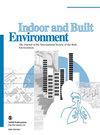Spatial and temporal distribution of bioaerosols produced by patients with different postures in a negative pressure isolation ward under different ventilation modes
IF 2.9
3区 工程技术
Q2 CONSTRUCTION & BUILDING TECHNOLOGY
引用次数: 0
Abstract
The high concentration of viral bioaerosols within the negative pressure isolation wards could pose a challenge to preventing potential cross-infection amongst healthcare workers (HCWs) and patients. Using the Euler–Lagrange methodology, this study numerically simulated the spatial and temporal distribution characteristics of bioaerosols in a typical negative pressure isolation ward as well as determined the interaction of ventilation mode and patient posture on ward ventilation performance. The removal effect of particle groups produced by two respiratory behaviours (breathing and coughing) was quantitatively analyzed, and the effect of exhaust air ratio and air exchange rate on particle distribution was discussed. The results showed that the migration characteristics of bioaerosol particles were sensitive to both the ventilation pattern and patient posture, which showed significant interactions. On this basis, the ventilation pattern with the best ventilation performance was evaluated, showing a particle removal effect of 70–85%. Due to the initial momentum difference, the diffusion behaviour of cough and breath particles was not consistent, but optimizing the airflow distribution near the exhaust outlet could improve their removal efficiency in the meantime. Further studies found that equal exhaust air velocity ratio facilitated the removal of aerosol particles, and an appropriate increase in the air exchange rate could also reduce the particle content.不同通风模式下负压隔离病房内不同姿势病人产生的生物气溶胶的时空分布情况
负压隔离病房内病毒性生物气溶胶的高浓度可能会对防止医护人员(HCW)和病人之间的潜在交叉感染构成挑战。本研究采用欧拉-拉格朗日方法,对典型负压隔离病房内生物气溶胶的时空分布特征进行了数值模拟,并确定了通风模式和患者体位对病房通风性能的交互作用。定量分析了两种呼吸行为(呼吸和咳嗽)产生的粒子群的清除效果,并讨论了排风比和换气率对粒子分布的影响。结果表明,生物气溶胶粒子的迁移特性对通风模式和患者姿势都很敏感,两者之间存在显著的交互作用。在此基础上,对通风性能最佳的通风模式进行了评估,结果显示颗粒去除效果为 70%-85%。由于初始动量差异,咳嗽和呼气微粒的扩散行为并不一致,但优化排气口附近的气流分布可在此期间提高微粒清除效率。进一步的研究发现,排气风速比相等有利于气溶胶颗粒的去除,适当提高空气交换率也能降低颗粒含量。
本文章由计算机程序翻译,如有差异,请以英文原文为准。
求助全文
约1分钟内获得全文
求助全文
来源期刊

Indoor and Built Environment
环境科学-工程:环境
CiteScore
6.40
自引率
25.00%
发文量
130
审稿时长
2.6 months
期刊介绍:
Indoor and Built Environment publishes reports on any topic pertaining to the quality of the indoor and built environment, and how these might effect the health, performance, efficiency and comfort of persons living or working there. Topics range from urban infrastructure, design of buildings, and materials used to laboratory studies including building airflow simulations and health effects. This journal is a member of the Committee on Publication Ethics (COPE).
 求助内容:
求助内容: 应助结果提醒方式:
应助结果提醒方式:


